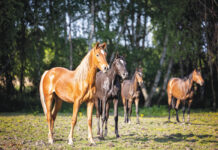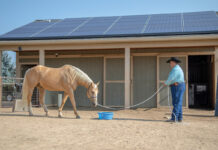
Horse Illustrated: Is there such thing as a “hot feed”?
Dr. Getty: So-called “hot feeds” typically contain large amounts of starch from cereal grains such as oats, corn and barley, as well as sugar from molasses. The vast majority of horses do not experience behavioral changes from these feeds. However, some are particularly sensitive to the temporary insulin peak stimulated by excessive glucose absorption (from starch digestion).
HI: What are feed sources that work well for hot horses, providing the nutrients and calories they need without overdoing it?
Dr. Getty: Forage is your foundation. If your horse requires additional calories for work or training, choose feed products that are low in sugar and starch, such as beet pulp, alfalfa meal, soybean hulls, distillers’ dried grains, stabilized rice bran and ground flaxseed. The diet should also have adequate magnesium, B vitamins, vitamin E and omega-3 fatty acids. Many sensitive, “high-strung” horses are simply exhibiting borderline deficiencies of these nutrients.
HI: Does the role of dietary staples such as pasture and forage differ for hot horses compared to the average horse in work?
Dr. Getty: Behavioral problems are often the result of stress, and this can affect all horses. Restricting forage is incredibly stressful. Hay and/or pasture must be available 24/7. It must continually flow through the digestive tract to avoid ulcers, colic, laminitis and negative habits.
Back to Making the Most of a Hot Horse >>
This article originally appeared in the October 2014 issue of Horse Illustrated magazine. Click here to subscribe!





